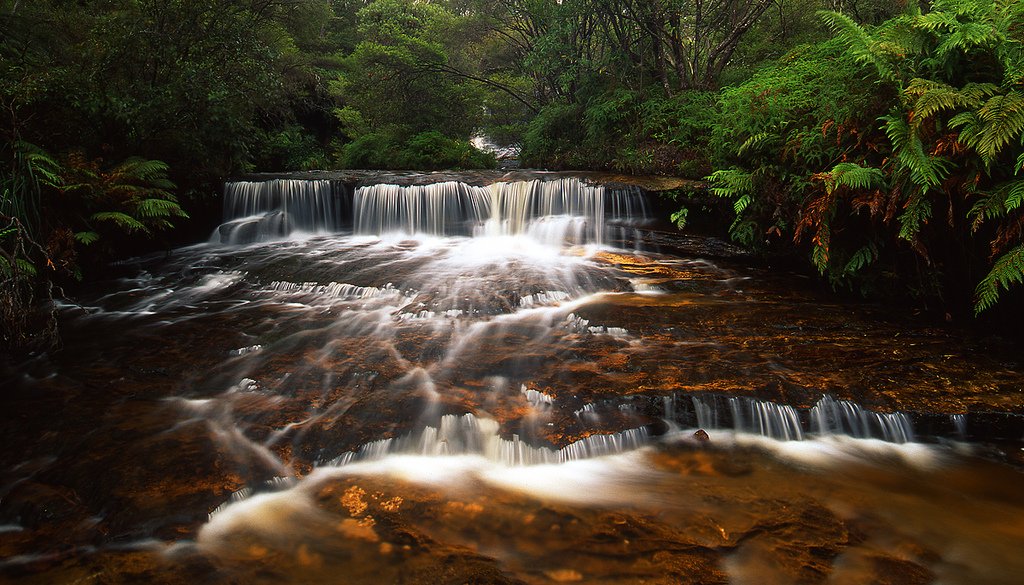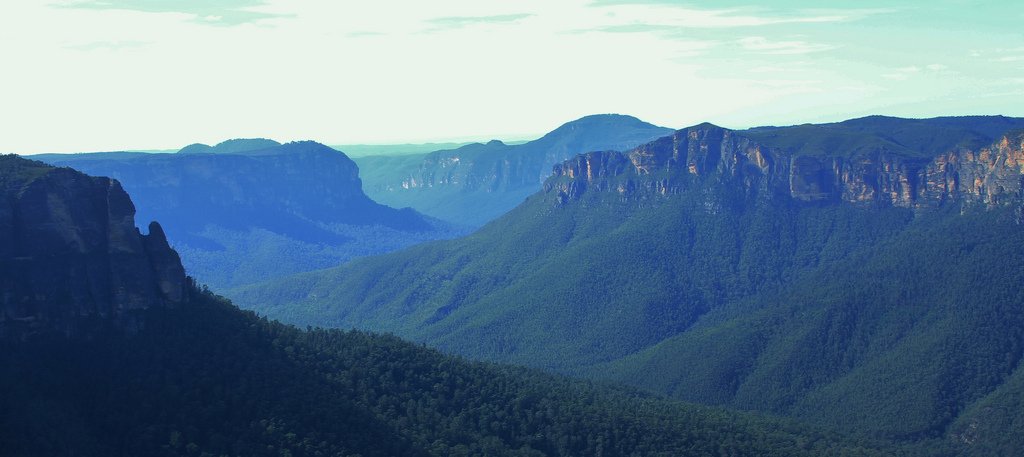Blue Mountains National Park
Blue Mountains is a huge 2481 km² national park with towering eucalyptus, fern thickets, swamps, waterfalls, cliffs and caves, located in the mountains of the same name.










Video: Blue Mountains National Park
The park’s flora includes characteristic tree species of the Australian rainforest: blue eucalyptus, tree ferns, acacia, mint tree. The fauna includes: gray kangaroo, mountain kangaroo (wallaroo), swamp wallaby, brush-tailed and ring-tailed possums and other marsupials. There are many exotic birds (red-headed fan-tail, Wong’s dove, Crimson prosella, yellow flycatcher, cave warbler living only in the Blue Mountains and others).
.When the first colonists arrived in Sydney, the Blue Mountains were considered impassable after several unsuccessful attempts to cross the area. In 1813, Wentworth, Blaxland and Lawson managed to find a passage, thus opening the western plains to settlement.
.
At the top of the mountain range at an altitude of over 1,000 meters is a magnificent plateau in which rivers have cut deep valleys over many millennia. The scenery here is magnificent – canyons with high walls, precipitous ravines, so that already by the beginning of the XX century three mountain resorts appeared here. Today, villages and towns line the ridge that surrounds the Blue Mountains National Park, an ideal place for hiking, rock climbing and rappelling. In 1994, a group of hikers exploring the canyon discovered a small grove of unique 30 m tall Wolemi pines, previously known only as a fossil plant.
.In 2000, the Blue Mountains National Park was listed as a UNESCO World Heritage Site. The Blue Mountains are protected, and it is forbidden to speed down the Three Sisters, the most famous peaks that have undergone massive erosion.
.
Attractions
The Blue Mountains amaze with their bright colorful landscape, changing depending on the sunlight, giving travelers unforgettable sunsets and sunrises. But they also hold many mysteries and legends, allowing you to learn more about the life and culture of the aborigines.
.
The hallmark of the park is the Three Sisters Rocks, which, according to local folklore, have an amazing history of formation. They are accessed by a “Giant Staircase” consisting of more than 800 steps.
Of particular interest are the caves located on the territory of the reserve. In Lyre-tail Lodge you can explore a shallow cave – an Aboriginal site, which is about 12,000 years old, and in the Red Hands Cave near Glenbrook you can see handprints and ancient drawings.
.
It is also advisable to go on a “wanderings” with a local guide from the Darug tribe. From him you will learn about the “singing trails” that connect sacred sites, and then bathe in the crystal clear “billabong” under the rainbow waterfall.
.
Speaking of waterfalls. The mesmerizingly beautiful Wentworth Falls sits at the very edge of the Jamison Valley. You can spend hours watching its waters tumbling down onto the rocks from almost three hundred meters high, and enjoy the views of the valley, walking along the trails, which it is marked along and across. Standing atop a narrow sandstone bed on Hanging, one can hear the echoes echoing over the giant forest valley and feel the majesty of nature.
.
Traveling to the Blue Mountains, tourists should see underground rivers, prehistoric rock strata and the huge mines of Jenolan Cave, the oldest of the underground caves. At the Mount Tomah Botanical Garden, you can be transported to antiquity by looking at the Jurassic pine tree, one of the oldest and rarest plants on earth..The Blue Mountains allow you to get closer to pristine nature and listen to the stories of the Creation Times that literally permeate the atmosphere of this wild life.
.Tourists
The Blue Mountains are a popular destination for tourists. The park’s record attendance was in 1999, when 1 million 45,000 people visited the park (for comparison, there were 687,000 visitors in 2008 and 563,000 in 2009).
.There are several observation decks within the park that offer breathtaking views of the valleys, cliffs and gorges below.
.For the adventurous, there is the Greater Blue Mountains Drive, a chain of connected highways and sightseeing trails that covers 10,000 km2 of the entire Blue Mountains. You can travel to the surrounding areas: Macarthur, Southern Highlands, Mudgee, Hunter Valley and Hawkesbury, or explore the enchanting sites of the Blue Mountains themselves: the Currajong, The Mountains, Blackheath and Megalong, located on 18 excursion trails. And if you’re tired of driving, hop on the Zig Zag Railway, a vintage steam locomotive that follows the ancient route from Bell to Lithgow.
.In the village of Katoomba, you can take a ride on the world’s steepest railroad or fly over the cliffs in the cab of a cable car. Here you can see Australia’s highest waterfall, the 305-meter-high Vallaman, which falls in one continuous stream. Activities also include mountain biking, long and short hikes, horseback or jeep rides. Along the hiking trails there are kiosks, cafes and small restaurants that will delight you with delicious national cuisine. And from June to August, you can witness Christmas festivities, roasts and puddings by the fire. What could be better than lovingly prepared food and the enchanting atmosphere of the mountains?
.Then feel the goosebumps running down your spine on a spirits tour or attend one of the monthly cave concerts with natural acoustics in the midst of a fairytale setting.
.Blue Mountains National Park is open from 8 a.m. to 6-7 p.m. 365 days a year. An adult ticket averages $11, children are free admission.
.
